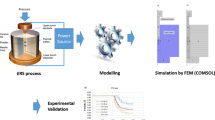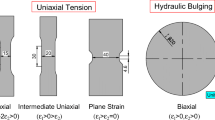Abstract
A mathematical model of stress–strain behavior is developed for the process of powder wire flattening. Modeling was based on a partition of the deformation zone at a set of elementary volumes and a joint solution of the plasticity condition for porous materials and the equation of static equilibrium of forces within the elementary volume. The proposed mathematical model takes into account the real character of geometric parameter distributions as well as the complex of mechanical properties and conditions of contact friction along the length of the deformation zone. A distinctive feature of this model is an accounting for shell deformation in the deformation zone. This allowed us to define more precisely the plastic deformation zone and take into account the effect of shell bending on the energy-power parameters of the process. The experiments confirmed the validity of the assumptions and the shell influence on the process parameters. The proposed modeling approach provides the possibility to predict and optimize the parameters of an electrode material made by pressure working of powder wire. The derived results of the numerical simulation may be useful in improving the efficiency of the subsequent deposit welding operations.
Similar content being viewed by others
References
Amirkhanlou S, Jamaati R, Niroumand B, Toroghinejad MR (2011) Manufacturing of high-performance Al356/SiCp composite by CAR process. Mater Manuf Process 26:902–907. doi:10.1080/10426914.2011.577879
Arora HS, Singh H, Dhindaw BK (2012) Composite fabrication using friction stir processing—a review. Int J Adv Manuf Technol 61(9–12):1043–1055. doi:10.1007/s00170-011-3758-8
Chandramouli R, Pandey KS, Kandavel TK, Ashokkumar T, Shanmugasundaram D (2007) Influence of material flow constraints during cold forming on the deformation and densification behaviour of hypoeutectoid P/M steel ring preforms. Int J Adv Manuf Technol 31(9–10):926–932. doi:10.1007/s00170-005-0272-x
Chekmarev AP, Klimenko PA, Vinogradov GA (1963) Investigation of specific pressure, specific friction, and the coefficient of friction during metal powder rolling. Sov Powder Metall 2(2):112–115. doi:10.1007/BF01111823
Chigarev VV, Belik AG, Gribkov EP, Gavrish PA (2015) A mathematical model of the process of rolling flux-cored tapes. Weld Int 26(9):718–722. doi:10.1080/09507116.2014.888192
Chigarev VV, Gavrish PA, Gribkov EP (2012) Investigation of the process of drawing flux-cored wire for welding copper to steel. Weld Int 29(1):70–74. doi:10.1080/09507116.2011.653152
Chigarev VV, Gavrish PA, Gribkov EP (2014) Improving the technological conditions of drawing flux-cored welding wires. Weld Int 28(1):59–61. doi:10.1080/09507116.2013.796655
Chitkara NR, Liaghat GH (2001) Working pressure, deformation modes and fracture in open-piercing of cylindrical disks made of compacted sintered aluminium powder. Int J Adv Manuf Technol 17(12):889–909. doi:10.1007/s001700170100
Danil’chenko BV (1989) Surfacing wear–self–protective powder. Autom Weld 5:38–41 (in Russian)
Druyanov BA (1989) Applied plasticity theory for porous bodies. Mashinostroenie, Moscow, p 168 (in Russian)
Dunaevskij VI, Samojlov VA, Satonin AV, Egorov AB (1994) A one-dimensional mathematical modeling of stress–strain state in the straightening stretch bending. Izv. vuzov Chernaja metallurgija. №9. - S. 44-47
Es-Saheb MH, Albedah A, Benyahia F (2011) Diametral compression test: validation using finite element analysis. Int J Adv Manuf Technol 57(5–8):501–509. doi:10.1007/s00170-011-3328-0
Fridman Ja. B (1974) Mechanical properties of metals / Ja.B. Fridman // V2t. T.1. Metallurgy and heat processing of steel. – M.; Mashinostroenie 472 s
Fu MW, Chan WL (2013) A review on the state-of-the-art microforming technologies. Int J Adv Manuf Technol 67(9–12):2411–2437. doi:10.1007/s00170-012-4661-7
Gogaev KA, Kalutskii GYA, Voropaev VS (2013) Contact stresses in the deformation zone and average pressure during asymmetric rolling of metal powders. Powder Metall Met C 52(3–4):126–131. doi:10.1007/s11106-013-9504-z
Gribkov EP, Perig AV, Danilyuk VA (2015) Research into the process of producing powder tapes. Int J Adv Manuf Technol 77(95–8):1087–1104. doi:10.1007/s00170-014-6496-x
Guigon P, Simon O (2003) Roll press design—influence of force feed systems on compaction. Powder Technol 130:257–264. doi:10.1016/S0032-5910(02)00223-1
Hirohata T, Masaki S, Shima S (2001) Experiment on metal powder compaction by differential speed rolling. J Mater Process Technol 111:113–117. doi:10.1016/S0924-0136(01)00492-7
Hrairi M, Chtourou H, Gakwaya A, Guillot M (2011) Modeling the powder compaction process using the finite element method and inverse optimization. Int J Adv Manuf Technol 56(5–8):631–647. doi:10.1007/s00170-011-3211-z
Kailas SV (2009) Influence of friction during forming processes—a study using a numerical simulation technique. Int J Adv Manuf Technol 40(11–12):1067–1076. doi:10.1007/s00170-008-1425-5
Karimi HR, Djokoto SS (2012) Instrumentation and modeling of high-pressure roller crusher for silicon carbide production. Int J Adv Manuf Technol 62(9–12):1107–1113. doi:10.1007/s00170-011-3871-8
Katashinskii VP, Shtern MB (1983) Stress–strain state of powder being rolled in the densification zone. I. Mathematical model of rolling in the densification zone. Powder Metall Met Ceram 22(11):882–885. doi:10.1007/BF00805540
Katashinskii VP, Shtern MB (1983) Stress–strain state of powder being rolled in the densification zone. Powder Metall Met Ceram 22(12):972–976. doi:10.1007/BF00802421
Kazeminezhad M, Karimi Taheri A (2005) An experimental investigation on the deformation behavior during wire flat rolling process. J Mater Process Tech 160(3):313–320. doi:10.1016/j.jmatprotec.2004.06.020
Kazeminezhad M, Karimi Taheri A, Kiet Tieu A (2008) A study on the cross-sectional profile of flat rolled wire. J Mater Process Tech 200:325–330. doi:10.1016/j.jmatprotec.2007.09.029
Keshavarz S, Khoei AR, Molaeinia Z (2013) Genetic algorithm-based numerical optimization of powder compaction process with temperature-dependent cap plasticity model. Int J Adv Manuf Technol 64(5–8):1057–1072. doi:10.1007/s00170-012-4053-z
Ksiezarek S, Kazana W, Ciura L, Marszowski K, Woch M (2011) Bimetallic wires: technology for their mechanical cold cladding and functional properties. Arch Metall Mater 56(4):891–895. doi:10.2478/v10172-011-0097-6
Kumakura H, Matsumoto A, Fujii H, Togano K (2001) High transport critical current density obtained for powder-in-tube-processed MgB2 tapes and wires using stainless steel and Cu–Ni tubes. Appl Phys Lett 79(15):2435–2437. doi:10.1063/1.1407856
Kumar S, Sharma V, Choudhary AKS, Chattopadhyaya S, Hloch S (2013) Determination of layer thickness in direct metal deposition using dimensional analysis. Int J Adv Manuf Technol 67(9–12):2681–2687. doi:10.1007/s00170-012-4683-1
Lambiase F, Di Ilio A (2012) Experimental and finite element investigation of roll drawing process. J Mater Eng Perform 21(2):161–166. doi:10.1007/s11665-011-9932-1
Mori K, Osakada K (1987) Analysis of the forming process of sintered powder metals by rigid-plastic finite-element method. Int J Mech Sci 29(4):229–238. doi:10.1016/0020-7403(87)90037-3
Murata Y, Yuasa E, Tanaka M (2009) Experimental analysis of metal flow and strain distribution in rolling of Sn-Pb powder. J Solid Mech Mater Eng 3(2):167–177. doi:10.1299/jmmp.3.167, Special Issue on Recent Advances in Materials and Processing
Nakamura Y, Inada R, Oota A (2003) Phase formation mechanism and properties of Ag-sheathed (Bi, Pb)-2223 tapes prepared by two-powder method. Physica C 392–396(2):1015–1019. doi:10.1016/S0921-4534(03)01157-2
Narayan S, Rajeshkannan A (2013) Influence of carbon content on workability behavior in the formation of sintered plain carbon steel preforms. Int J Adv Manuf Technol 64(1–4):105–111. doi:10.1007/s00170-012-4002-x
Otrok AI, Vinogradov GA, Katrus OA, Katashinskii VP (1973) Compressibility of heterogeneous powder mixtures in rolling. Sov Powder Metall 12(1):17–22. doi:10.1007/BF00803969
Perig AV, Golodenko NN (2014) CFD 2D simulation of viscous flow during ECAE through a rectangular die with parallel slants. Int J Adv Manuf Technol 74(5–8):943–962. doi:10.1007/s00170-014-5827-2
Perig AV, Golodenko NN (2014) CFD simulation of ECAE through a multiple-angle die with a movable inlet wall. Chem Eng Commun 201(9):1221–1239. doi:10.1080/00986445.2014.894509
Perig AV, Golodenko NN (2015) ECAP process improvement based on the design of rational inclined punch shapes for the acute-angled Segal 2θ-dies: CFD 2-D description of dead zone reduction. Mech Sci 6(1):41–49. doi:10.5194/ms-6-41-2015
Perig AV, Laptev AM, Golodenko NN, Erfort YA, Bondarenko EA (2010) Equal channel angular extrusion of soft solids. Mat Sci Eng A-Struct 527(16–17):3769–3776. doi:10.1016/j.msea.2010.03.043
Petrosyan GL (1979) The deformation theory of plasticity of porous materials. Izvestiya vuzov. Mech Eng 11:5–8 (in Russian)
Potapkin VF, Levkin AN, Satonin AV, Romanov SM, Vorob’yev YA, Gribkov EP (2000) Stress state and kinematics for rolling of powered materials on metal substrate. Powder Metall Met C 39(1–2):11–17. doi:10.1007/BF02677434
Przondziono J (2008) Flattening of narrow and thin stainless steel strips. Arch Mater Sci Eng 29(2):121–124, http://www.archivesmse.org/vol29_2/29211.pdf
Ramakrishnan M, Muthupandi V (2013) Application of submerged arc welding technology with cold wire addition for drum shell long seam butt welds of pressure vessel components. Int J Adv Manuf Technol 65(5–8):945–956. doi:10.1007/s00170-012-4230-0
Rumiński M, Skołyszewski A (2003) Some aspects of manufacturing and application of flattened wires. In: ESAFORM : proceedings of the 6th [sixth] international ESAFORM conference on material forming : Salerno, Italy April 28–30, 2003. Nuova Ipsa Editore, Palermo, pp 743–746
Simon O, Guigon P (2003) Correlation between powder-packing properties and roll press compact heterogeneity. Powder Technol 130:257–264. doi:10.1016/S0032-5910(02)00202-4
Soltanian S, Wang XL, Li AH, Collings EW, Sumption MD, Lee E, Liu HK, Dou SX (2002) Fabrication and critical current density in 16-filament stainless steel/Fe/MgB2 square wire. Solid State Commun 124(1–2):59–62. doi:10.1016/S0038-1098(02)00380-0
Stepanenko AV, Isaevich LA, Kharlan VE (1990) Geometric and power parameters of the metal powder rolling process. I. Boundaries of the seat of deformation and stress field in the lag and forward slip zones. Powder Metall Met Ceram 29(2):101–105. doi:10.1007/BF00794530
Stepanenko AV, Isaevich LA, Kharlan VE (1991) Geometric and energy-force parameters of the process of rolling of metal powders II. The rolling power, moment, and contact stresses and distribution of density in the area of deformation. Powder Metall Met Ceram 30(2):101–105. doi:10.1007/BF00797280
Storozhev MV (1977) Theory of metal forming: a textbook for high schools / M. V. Storozhev, E. A. Popov. – 4-e izd., pererab. i dop. – M.: Mashinostroenie 423 s
Tseng H-C, Hung C, Huang C-C (2010) An analysis of the formability of aluminum/copper clad metals with different thicknesses by the finite element method and experiment. Int J Adv Manuf Technol 48(9–12):1029–1036. doi:10.1007/s00170-009-2446-4
Vajpai SK, Dube RK, Sangal S (2011) Processing and characterization of Cu-Al-Ni shape memory alloy strips prepared from prealloyed powder by hot densification rolling of powder preforms. Metall Mater Trans A 42(10):3178–3189. doi:10.1007/s11661-011-0728-6
Vallellano C, Cabanillas PA, García-Lomas FJ (2008) Analysis of deformations and stresses in flat rolling of wire. J Mater Process Tech 195(1–3):63–71. doi:10.1016/j.jmatprotec.2007.04.124
Vernik EB, Katrus OA (1974) Effects of the surface roughness of rolls on the powder rolling process. Sov Powder Metall 13(7):534–538. doi:10.1007/BF00792556
Vinogradov GA, Katashinskij VP (1979) Theory sheet rolling metal powders and granules. Metallurgy, 224 (in Russian)
Volkogon GM, Dmitriev AM, Dobryakov EP (1991) Advanced technological processes stamping parts from powders and equipment. Mechanical Engineering, 320 (in Russian)
Wang PT, Karabin ME (1994) Evolution of porosity during thin plate rolling of powder-based porous aluminum. Powder Technol 78(1):67–76. doi:10.1016/0032-5910(93)02768-6
Zheng Z-X, Xia W, Zhou ZY (2013) Experimental and numerical modeling for powder rolling. Rev Adv Mater Sci 33:330–336, http://www.ipme.ru/e-journals/RAMS/no_43313/05_433_zheng.pdf
Zhudra AP (2009) New equipment for welding cones and bowls charging devices. Autom Weld 9:57–59 (in Russian)
Zhudra AP (2010) Durable powder surfacing ribbons. Welder 6:6–10 (in Russian)
Zorc B, Kosec L (2005) Geometrical models for the deformation of round reinforcement wires when compressing a reinforced brazed joint. Mater Tehnol 39(5):155–161, http://mit.imt.si/Revija/izvodi/mit055/zorc.pdf
Author information
Authors and Affiliations
Corresponding author
Ethics declarations
Disclosure
The submission of the authors’ paper implies that it has not been previously published, that it is not under consideration for publication elsewhere, and that it will not be published elsewhere in the same form without the written permission of the editors.
Conflict of Interest
The authors declare that they have no conflict of interest.
Rights and permissions
About this article
Cite this article
Gribkov, E.P., Perig, A.V. Research of energy-power parameters during powder wire flattening. Int J Adv Manuf Technol 85, 2887–2900 (2016). https://doi.org/10.1007/s00170-016-8714-1
Received:
Accepted:
Published:
Issue Date:
DOI: https://doi.org/10.1007/s00170-016-8714-1




